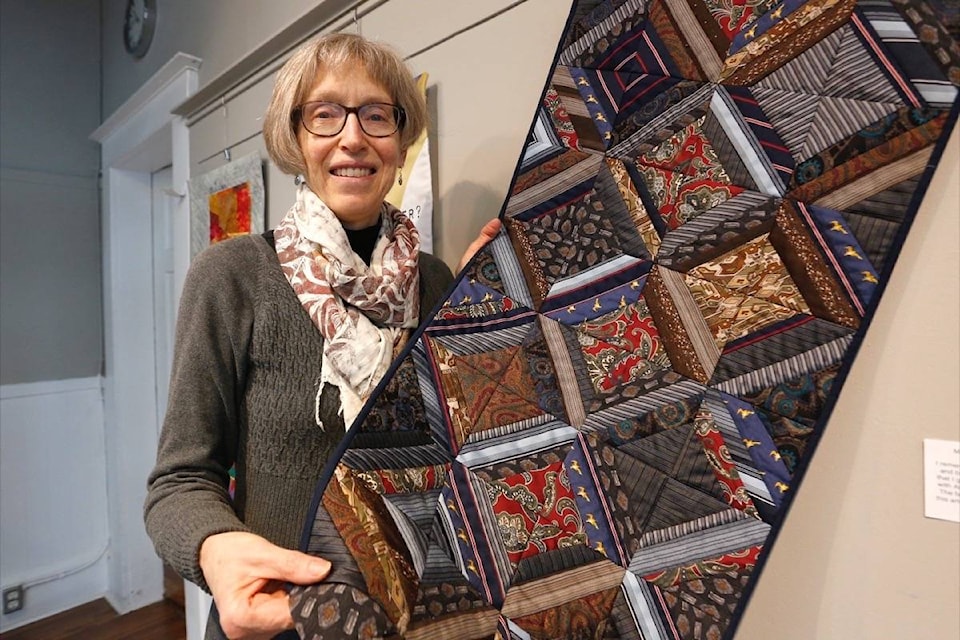As fibre artist Margie Davidson continued to lose her father to alzheimer’s “little by little” several years ago, she one day asked her stepmother for his ties.
Davidson’s father was exceedingly precise, she said — he worked at an oil company in an office where he organized a national tank car fleet.
“He was a person that wore a suit and tie to work,” said Davidson. “His ties really are a reflection of him and who he was like.”
Those ties now make up Davidson’s fibre art piece, currently on exhibit at the MAC (The McMillan Arts Centre at 133 McMillan St. in Parksville).
The piece is one of 48 in a traveling exhibit by Fibre Art Network (FAN) members. Called Ekphrastic, the exhibit’s premise is to flip on its head the idea of ekphrastic poetry, which is inspired by a scene or work of art.
In Ekphrastic, 12 pieces of poetry written by Canadian poets for the exhibit serve as the inspiration for four pieces of fabric art each.
The exhibit runs from Feb. 27 to April 14. The first 24 pieces are displayed until March 18, the second 24 will go up March 19.
Davidson’s piece is in the current display, and is inspired by a piece of poetry called Elegy by Carla Funk.
“An elegy for a father that has passed away,” said Davidson, a recent arrival to Qualicum Beach.
“At the time my father had been diagnosed with alzheimer’s and I was losing him little by little by little, and every time I would go to visit him in Ontario, he would be less there,” she said while sitting in the exhibit space at the MAC.
That poem grabbed hold, said Davidson, because, even though the father it talked about was quite different from hers, some of the same emotions were there.
The poem talks about woodsmoke and whiskey, leather and oiled rifle barrels. “He’s not like that at all,” said Davidson of her father.
“He was a person that wore a suit and tie to work and was organized and he was a quiet, subdued man,” she said. “He was very precise and organized, and even after he retired, there was a preciseness about my dad. The way he shovelled his driveway when it snowed, there was a way to do it.
“If you helped him clean the car, there was a set way, an order… And if you ever watched him mow his lawn, you knew that he was working on the pattern that was the most efficient.”
The ties that Davidson used — light and dark blues, reds and burnt orange with paisley and stripes — became a precise geometric set of diamond shapes which, at the top, are carefully aligned. But as you look down, the sections become less exact.
“They sort of start to fall apart,” she said. “That was my observation and feelings about what it was like to have my father not be my father anymore in the way the alzheimer’s, the disease, was taking over: his losing of words, his mixing-up of ideas, and all those other aspects of alzheimer’s that was hard on him.”
Davidson’s father has since passed away, she said.
Looking at the piece of art she made, Davidson said she’s happy for having cut up and repurposed those ties.
“A tie is a very intimate piece of clothing. I mean, it goes around someone’s neck, and it’s really a part of their presence, whether it’s going to church, whether it’s going to the office, whether it’s going to a funeral, those are the kinds of places where you would wear a tie,” she said.
But Davidson said she realized those ties no longer had a use for her father.
“He wouldn’t have been able to tie it, he wouldn’t have been going to places, his world got smaller and smaller. So there is something quite intimate about touching those fabrics and cutting up those fabrics, and changing their purpose. That felt like important work,” she said.
In thinking about her father, her memories of him, the disease and herself while making what became her elegy to her father, Davidson said, “I came out a stronger person from having worked on this piece.”
That is just one of four interpretations of that same poem, and one of 48 interpretations of poetry in the Ekphrastic exhibition.
Davidson will be giving a free talk on her piece, on FAN and the Ekphrastic exhibit, on Thursday, March 29 from 1:30 p.m. to 3 p.m. at the MAC.
For more info on the exhibit, go to mcmillanartscentre.com/free-artists-talk-ekphrastic-exhibit/.
For more on FAN, go to www.fibreartnetwork.com.
